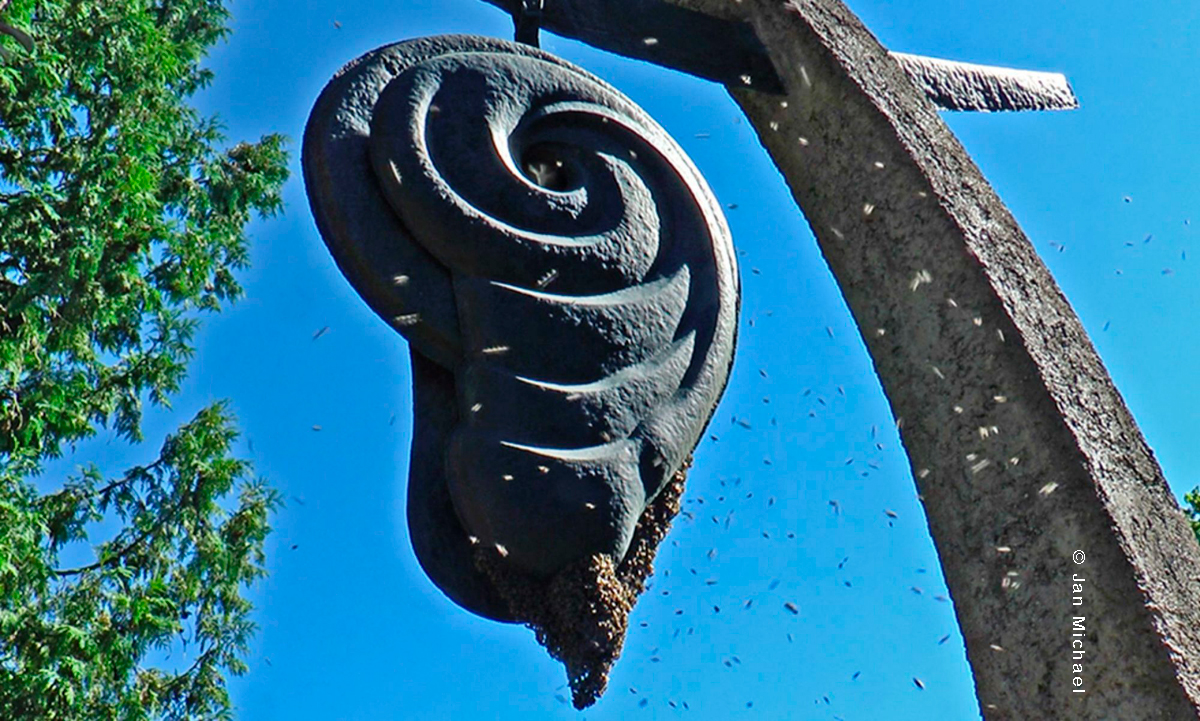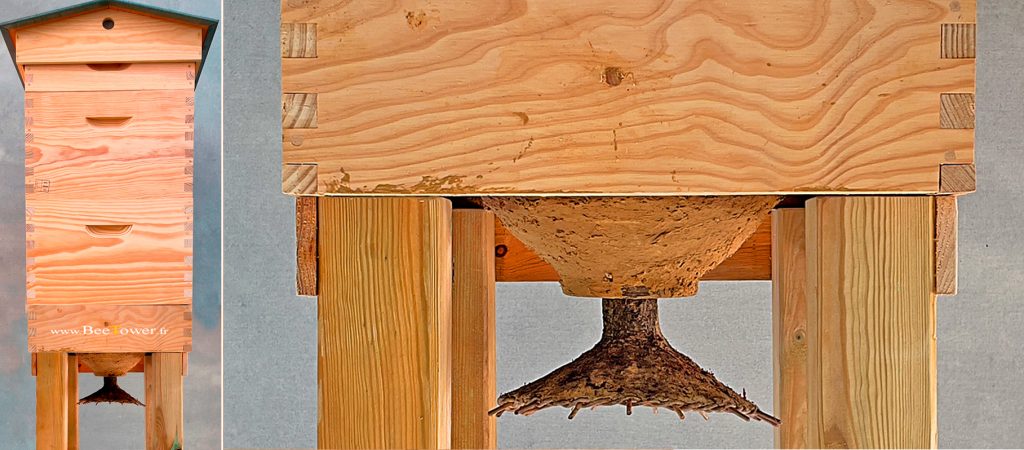
Günther Mancke studied at the Academy of Fine Arts in Düsseldorf, Germany, under Professor Mattaré, to whom he owes his particular approach to art, the environment and, above all, bees. After the Second World War, Günther Mancke settled in the Eifel with a few fellow students. In the middle of the forest, in a landscape that was still intact at the time, he founded an artists’ colony in Weißenseifen, which was extended a few years later to include a home for curative education.
How did you become interested in bees?
In the 50s, a farmer gave me a hive, a very narrow hive, painted blue. When you get new bees, you sit in front of it for hours. I couldn’t make the connection between my inner self and my outer appearance, and that’s the essential principle that has guided my whole development. Inside, the buzz and warmth of the popular being, the warm and unlikely smell of such a box, I couldn’t make them coincide with the narrowness of the chest and especially with the colour blue, where you can only feel cold. So, as best I could, I made some straw stakes and was very pleased with them. The straw material was just right for me, the sunny yellow colour and the round shape.
I did it for a while and at some point, I can’t remember why, I stopped.
A few years later, I took up beekeeping again and I looked at these beautiful romantic hives and I came to the conclusion that it wasn’t that, that they certainly had a rounded plan, that they therefore had a certain form of warmth and that they were finished at the top, but that at the bottom, it was just a cylinder.
So I looked into the matter and made some plans, as I had imagined. Then I came across a book that depicted a free construction in a tree, and which showed in a marvellous way the whole of the people as it appeared. Later, I myself saw a beehive completely covered in wax. The bees had built themselves a real home
Does this mean that the bees hung freely in the tree a colony of bees that freely built its combs in the tree.

Then I discovered the chain curve: I had 13 to 15 experimental colonies, including a test bed in the living room – I made a hole in the wall through which the bees could fly to the observation box, so that I could observe the progress of the construction, I hung a chain on it every day and I saw: whatever the curve, it’s always a chain curve. I then saw the link between the construction bees that hang in a chain. I followed this trail with precision.
The hanging basket I developed is shaped like a chain. I then rounded off the lower part, so that the whole thing has a certain egg shape, and therefore also a thermal shape, with the approach funnel at the bottom. I then worked on it for a few years and kept making improvements. At the time, I still had an alternative, because I thought that people would probably not be so quick to accept that such an object should be suspended, and especially not at a height of 2.50 m – which is what bees need. So I developed exactly the same principle as a free-standing basket. The internal structure is exactly the same – both are arched hives. Then I said to myself that if I was going to use hanging hives, it had to be consistent and I didn’t go back to standing hives.You then developed something unusual in the principle of the baskets, this mobility of the cells.
Yes, it’s a combination of stable and mobile construction. In fact, it’s a stable construction, where you can check and intervene if necessary.
And then it’s simply « suspended in the sky »?
Yes, exactly, and you can see what’s inside, there can only be one insect inside, and this basket was in fact the answer to my initial question: what is the content and the form, what is the relationship between content and form.
Does this mean that the bees hung freely in the tree a colony of bees that freely built its combs in the tree.

It’s a very particular artistic question, which is not at all sought after these days.
You met Thomas Radetzki at a beekeepers’ conference and showed him your plans for the hanging baskets.
Yes, that’s how it happened. And that’s how the plastic arts courses came about, over the years. Then, over the years, we developed the land near the Fischermühle bee mill: the sculpture was born, with the lamp and the central body. The central body will also have a shape, and maybe it will be finished.
Yes, we did some sculpting, and then at a certain point we asked ourselves the question of a work of beekeeping art. For this work of art, one specific question was important: how to express the inner essence of the bee in a plastic, artistic object.

That was the starting point. We then realised it in the concrete arch as a terrestrial element and in the celestial curve, then in the arrangement of the honeycomb in two different directions: towards the entrance, it’s an active centrifugal spiral movement with a look inwards, where the golden bee presents itself to us; the rear has more of a dream element in its design.
This work of art once again expresses your desire to make content visible through form.
I could go on and on…
Extract from Text:Interview by Thomas Radetzki, Oktober 2003
On 30 September 2020, Günther Mancke died at the age of 95.
Translated from the German by DeepL AI. Multimedia by Jan Michael
Summary from the point of view of protecting bees
This hive, also known as SUN HIVE, is very popular with alternative beekeepers in many countries and has many admirers in Germany, the UK, the Netherlands and the USA, as well as a few in France.
We learned from Günther that bees naturally build their cells in the shape of the chain with the corresponding ovoid curves. The SUN HIVE design developed by Günther Mancke is therefore the ideal shape that adapts perfectly to the nature of bees and can rightly be described as natural beekeeping. A bee house that comes as close as possible to this shape and is well insulated from the outside would then be the best hive from the bees’ point of view, because there are no corners or surfaces inside where moisture and cold air can accumulate, allowing the bees to survive better.
The possibility of opening the brood nest and the use of frames certainly helps the beekeeper, but not the bees. This compromise, which Gunther probably made out of consideration for certain beekeepers, is an obstacle to nature-friendly beekeeping and, from the point of view of bee protection, requires some modifications to this ideal habitat.
We can proudly say that the Sunhive (Weissenseifener Hängekorb) has been used for the first time since 2014 on our Villa le Bosquet school apiary in France.
Now I’ve rediscovered my old, abandoned SUN HIVE in a new light, and have grown to love the basket design all the more.
I’ve transformed the hive accordingly, without making any compromises, and from the bees’ point of view, it’s probably a perfect shelter for better survival in the era of climate change.
Text: JAN MICHAEL, the Villa le Bosquet school apiary team
The Sun Hive-C
In order to meet the challenges of climate change and to simplify the use of Sunhive, which until now has been a little complicated, we have made a few changes to the hive.
For more information, click here

